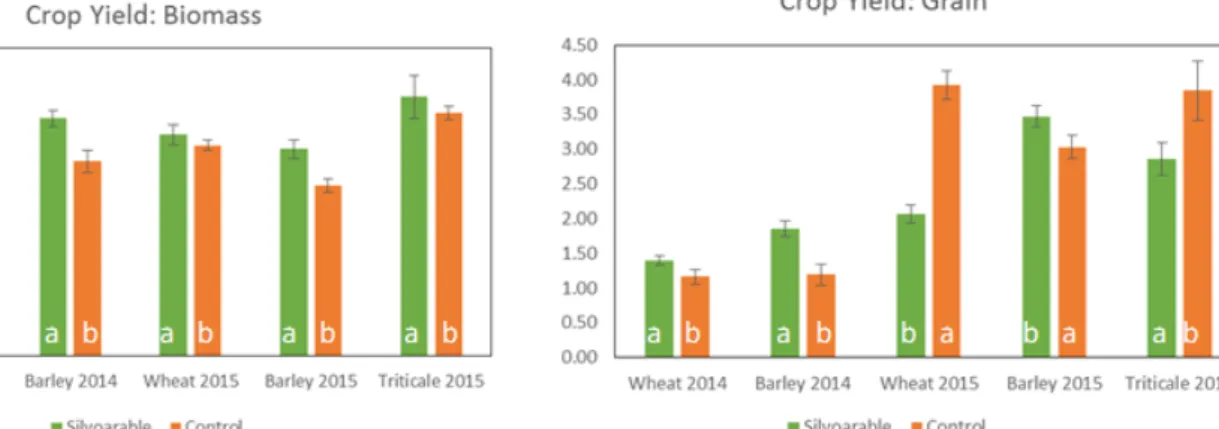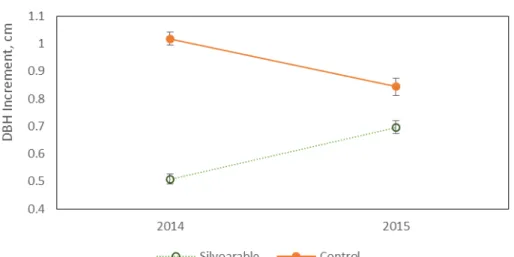3rd European Agroforestry Conference – Montpellier, 23-25 May 2016 Agroforestry and climate change (oral)
208
CROPPING AMONG TREES TO COPE WITH CLIMATE
CHANGE. INSIGHTS FROM CEREAL CULTIVATED IN
WALNUT PLANTATIONS OF CENTRAL SPAIN
Arenas-Corraliza G1, Mantino A2, López-Díaz ML1, Moreno G1*
* Correpondence author: [email protected]
(1)INDEHESA–Forest Research Group, University of Extremadura, 10600 Plasencia, Spain(2) Institute of Life Sciences, Sant'Anna School of Advanced Studies, Pisa, Italy
Introduction
Food production should at least double in this century to nourish the increasing human population. However, little increase in agricultural area is possible if we are to meet rival demands on the land for food and fuel production, whilst protecting the environment and reducing the emissions of greenhouse gases. We need to design more productive and sustainable production systems. However, current farming practices are based on high management inputs (chemical and energy) and a short list of crop species and cultivars. Crop yield potential has stagnated and further increases of production per unit of land surface will be difficult in the near future (Brisson et al. 2010; Ray et al. 2012).
Moreover, some reduction in the crop yields can be expected as consequence of the climate change. Brisson et al. (2010) showed that although genetic improvements are still being made to crops, this is partly counteracted since the 1990 due to climate changes which are unfavorable to cereals in temperate climates due to heat-stress during the grain filling phase and drought during stem elongation.
Cultivating among trees (Silvoagriculture) can help mitigate the effects of climate change and the increased frequency of extreme weather events. Spaced trees help to regulate the climate beneath them, reducing extremes of temperature, sheltering against wind and reducing evaporative demand from the soil surface. Indeed, it is well documented that trees have a major role in Mediterranean wood-pastures in stabilizing grass production through the typically variable seasonal rainfall (Gea et al. 2009; De Miguel et al. 2013).
Experiences in an agroforestry system that combine durum wheat (Triticum turgidum L. subsp. Durum) with Juglans x intermedia Ng23xRa show that the trees are able to capture some residual nitrogen wash below the area occupied by the root system of wheat (Andrianarisoa et al. 2015). And the tree fine roots can be vertical and horizontally modified by the presence of the crop, developing deeper rooting profiles than in pure plantations (Cardinael et al. 2015). In this work we tested the cereal crop yield and hybrid-walnut growth in a silvoarable experiment. We look for the best shade-adapted cultivars of cereal to be cultivated in silvoarable farms of Central Spain where early heat waves are damaging cereal crops.
Material and methods
The study was carried out in an experimental silvoarable plantation that combine hybrid walnut (hybrid Mj209xRa Juglans major that comes of the pollination from J. major with pollen of J. regia;) planted in 2007 for quality timber (tree height ranged 10-11 m in 2014) with annual crops (winter cereals: wheat, barley and triticale). The experiment includes the respective control plots of cereal without trees, and of walnuts without intercrops. The experiment is located at El Carpio de Tajo (Toledo, Spain; coordinates: ETRS 89 UTM 30 N = 374444 W; 4411877 N), at 411 m of altitude, mean annual temperature of 15,3 °C and 437.6 mm of mean annual precipitation. The soil is a Fluvisol, > 140 cm depth, pH ~ 6, clay loam texture. The management is intensive with irrigation and fertilization. The plot has a total area of 68.4 ha, of which 0.5 ha were under study. Three replicated plots of 20x4 m were selected as pure plantation control. There were 5 replicated plots of 20 x 4 m with the silvoarable combination. In 2013-2014 growing season 2 varieties of wheat (Kilopondio and Bologna) and 2 of barley (Azara y Doña Pepa) were tested. In 2014-2015 the cultivars were Ingenio, Sublim and Nogal for wheat and Basic, Lukhas, Hispanic and Dulcinea for barley. This second year, a local variety of triticale (Verato) was also tested. The agriculture control plots consisted of 4 replicate plots of a size of 2 x 2 m for each cultivar.
The study started in autumn 2013 where all plots were fertilized with 600 kg ha-1 of NPK 8:12:12. In spring 2014, 120 kg urea (46%) ha-1 was applied. Same doses were applied in 2014 2015.
3rd European Agroforestry Conference – Montpellier, 23-25 May 2016 Agroforestry and climate change (oral)
209
The diameter of the trees at breast height was measured in February 2014, 2015 and 2016. Crop yield was measured through 3-4 herbage samples (50x50 cm) per plot, which were taken using hand clippers at a height of 2.5 cm in June 2014 and 2015.
Results
Crop biomass was higher in silvoarable than in control plots in both years and for most the crop species and cultivars, with the exception of Bologna wheats (Table 1, Figure 1). For grain production, the response differed among species and cultivars (𝐹5−200= 5.196; P<0.001) and
presented marked differences between years (Figure 1). Barley yield was higher in silvoarable plots than in control ones both years, mainly Basic cultivar (p = 0.044) (Table 1). For wheat, differences were less significant in the first year. In the second year, the grain production was higher in the control plot, especially for cultivars Sublim (p < 0.001) and Nogal (p = 0.0012). Triticale was more productive in the control treatment in the only year studied.
Figure 1: Crop yield (biomass and grain) of cereal species in 2014 and 2015. Letters denote significant differences (p < 0.05) among control and silvoarable treatments within each species and year.
Table 1: Biomass and grain production for all the cultivars tested. * denotes significant differences among control and silvoarable treatments (p < 0.05) within each cultivar and year.
Year Species Cultivars Biomass (Mg / ha) Silvoarable Control Grain (Mg / ha) Silvoarable Control 2014 Barley Azara 7.60±0.37 6.14±0.49 * 1.77±0.18 1.09±0.11 *
Barley Doña Pepa 7.83±0.41 6.50±0.57 * 1.94±0.15 1.30±0.30 * Wheat Kilopondio 8.43±0.39 7.92±0.29 * 1.33±0.08 1.20±0.19 ns Wheat Bologna 8.14±0.44 8.53±0.43 ns 1.46±0.12 1.13±0.12 * 2015 Barley Basic 6.12±0.50 5.35±0.36 * 3.22±0.27 2.29±0.37 * Barley Lukhas 7.57±0.78 7.38±0.58 ns 3.91±0.44 3.31±0.43 * Barley Hispanic 7.24-0.53 4.79±0.12 * 3.68±0.25 3.24±0.22 * Barley Dulcinea 5.96±0.39 5.25±0.25 * 3.08±0.17 3.19±0.28 ns Wheat Ingenio 6.97±0.67 6.19±0.16 * 2.06±0.25 2.58±0.26 * Wheat Sublim 7.70±0.55 7.55±0.25 ns 2.36±0.26 5.25±0.20 * Wheat Nogal 6.90±0.45 6.27±0.20 * 1.81±0.17 2.94±0.21 * Triticale Triticale 8.41±0.68 7.89±0.22 * 2.86±0.24 3.85±0.43 * Differences in tree growth (annual increment of DBH) were much higher among years that between treatments (Figure 2). Growth was higher in the control treatment in both years, being difference more important during the first year.
3rd European Agroforestry Conference – Montpellier, 23-25 May 2016 Agroforestry and climate change (oral)
210
Figure 2: Tree growth in silvoarable and control treatments in 2014 and 2015.
The two years studied showed differences in total annual precipitation (387 mm and 284 mm 2013-2014 in 2014-2015) and especially in the distribution of these throughout the year (Figure
3). The year 2013-2014 had, in agronomic terms, a dry fall, a wet winter and dry spring.
However, the year 2014-2015 was wet in autumn and spring, and dry in winter. Overall, rains spread better over the growing period in the second year. Daily maximum temperatures followed similar patterns in both years, with some important heat waves at March and April in both years (Figure 3). In the first year, a heat wave coincided with the flowering phenophase of the cereal crop.
Figure 3: Monthly precipitation (left) and daily maximum temperature for two years studied. Data from the Servicio de Asesoramiento al Regante de Castilla – La Mancha (SIAR). Station “Vegas de San Antonio” (UTM X=354803; Y=4424260)
Discussion
The results show an increased production of crop biomass for all the species and cultivars and both years, demonstrating a positive effect of trees, presumably through reinforced soil fertility and shelter against cold winters. However, in terms of grain yield, trees affected only barley positively during the two years studied. For wheat and triticale effect was either neutral (wheat in the first year) and negative (wheat and triticale the second year). The shorter cycle of barley compare to wheat and triticale (Lopez-Bellido, 2010), allowed barley to scape to the excessive loss of sun radiation produced with the walnut budbreak. In our study when walnuts spread their leaves, barley had already flowered and initiated the grain formation, while wheat and triticale were not.
However, tree grew slower when combined with cereal crop, regardless of the cereal specie and cultivar. This means that competition for soil water among cereal plants and walnut trees matters. Surprisingly, the second year, when cereal production was higher, differences among intercropped trees and control trees in terms of DBH growth was lower, indicating the importance of temporal distribution of rains. The second year, with a better distribution of the rains, trees suffered less the competition
3rd European Agroforestry Conference – Montpellier, 23-25 May 2016 Agroforestry and climate change (oral)
211
Conclusion
We conclude that combining cereal of short-cycle cereals and late sprouting walnuts, cereal yield could be increased respect to open field crops. Partial shade could help cereal to scape to the lately often spring heat waves that is frequently damaging cereal crops in Mediterranean countries. However, silvoarable combinations depend on cultivars that were selected for full-light conditions. Our results suggest that selection programmes for cereals adapted to partial shade will be a promising adaptation strategy in the face of climate change.
Acknowlegments
This work is funded by AGFORWARD project (Grant Agreement N° 613520) is co-funded by the European Commission, Directorate General for Research & Innovation, within the 7th Framework Programme of RTD, Theme 2 - Biotechnologies, Agriculture & Food.
References:
Aletá N, Vilanova A (2011) Evaluación del crecimiento y la producción de nogal. Navarra forestal 28: 11–16. Andrianarisoa KS, Dufour L, Bienaimé S, Zeller B, Dupraz C (2015) The introduction of hybrid walnut trees (Juglans
nigra 3 regia cv . NG23) into cropland reduces soil mineral N content in autumn in southern France.
Agroforestry Systems 90: 193-205.
Brisson N, Gate P, Gouache D, Charmet G, Oury F-X, Huard F (2010) Why are wheat yields stagnating in Europe? A comprehensive data analysis for FranceField Crops ResearchVolume 119, Issue 1, 9 October 2010, Pages 201–212.
Cardinael R, Mao Z, Prieto I, Stokes A, Dupraz C, Kim JH, Jourdan C (2015) Competition with winter crops induces deeper rooting of walnut trees in a Mediterranean alley cropping agroforestry system. Plant Soil 391: 219– 235.
Coello J, Becquey J, Gonin P, Ortisset J.P., Baiges T, Piqué M (2009) El Nogal Híbrido (Juglans x intermedia) y el
Nogal Común (J.regia) para Madera de Calidad. Proyecto POCTEFA 93/08 Pirinoble, Centre de la Propietat
Forestal, Generalitat de Cataluña. 13 pp.
De Miguel JM, Acosta-Gallo B, Gómez-Sal A (2013) Understanding Mediterranean Pasture Dynamics: General Tree Cover vs. Specific Effects of Individual Trees. Rangeland Ecology & Management 66: 216-223.
Gea-Izquierdo G, Montero G, Cañellas I (2009) Changes in limiting resources determine spatiotemporal variability in tree-grass interactions. Agroforestry Systems 76: 375-387.
López - Bellido L (2010) Abonado de los cereales de invierno: trigo y cebada. Guía Práctica de la Fertilización Racional
de los Cultivos en España. Parte II. Madrid: Ministerio de Medio Ambiente y Medio Rural y Marino. pp. 123–
133.
Ray DK, Ramankutty N, Mueller ND, West PC, Foley JA (2012) Recent patterns of crop yield growth and stagnation.

